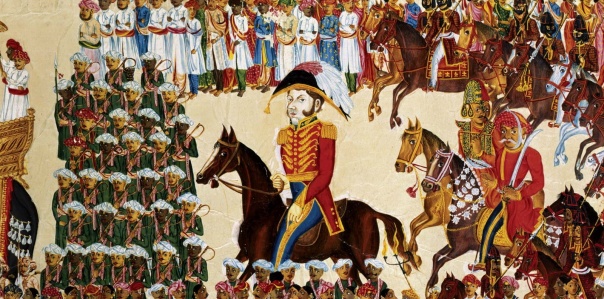
Last week I had the pleasure of sitting down with Cole and Drew Wehrle and Travis Hill for a (digital) play of the latest build of John Company’s second edition. I’m not prepared to discuss any details; the game isn’t finished, and anyway the version I played was a departure from the build Cole had shown before, even among playtesters. Drew and Travis were as unprepared as I was for what happened over the next two hours.
But with both John Company and An Infamous Traffic soon to receive new editions — and given Cole’s tendency to revisit the statements made by his work, as discussed in my examination of Pax Pamir’s two editions — this seems like a good time to sit down and crystallize a few thoughts about what his games argue and how they argue it.

Trade and conflict in John Company.
Today’s topic arose courtesy of Chris Bennett, game designer and adjunct lecturer at Stanford (you can read one of his articles here), who not only asked the question but also pushed for more detail when my first response was perfunctory. An Infamous Traffic and John Company have considerable overlap, both thematically and as playthings. Both feature negotiation. Both are satirical. Both deal with English patronage. Both alternate between sober introspection and wicked humor. In both cases, these facets arise from the games’ postcolonial nature. Although they’re set in different theaters — China and India respectively — both jab at the notion of the “Orient” and the efforts of British trade companies to exploit it. One gets the sense that Wehrle started with Edward Said’s Orientalism and kept reading.
Yet for all their similarities, there are crucial differences between them. And more than differences, divergent focuses that cohere to make a single statement. In a sense both games are strengthened through a paratextual reading: An Infamous Traffic says one thing, John Company says another, but when placed in parallel they speak together to form a statement that’s more than the sum of their (already quite coherent) parts. One might say they harmonize into a single board gaming diptych.
Let’s begin by discussing them one at a time.

Opium Smokers, Lai Afong, ~1880.
I. An Infamous Traffic
An Infamous Traffic is about peddling heroin. It’s easy to forget that the “addled Chinaman” trope is an inversion of history; that London’s hazy opium dens weren’t exports from China, but rather imports into China — and forced imports at that.
First, some quick history. Opium wasn’t new to China. It had been introduced over a millennium earlier during the Tang Dynasty, one of many goods delivered by Arab traders. It was spoken of favorably by pharmacologists in both China and Europe, who used it as a medicine for vigor and virility. For centuries it remained too expensive to enter widespread use, limiting it to diluted medicinal functions or sporadic recreational use by the wealthy. Like many substances touted as cures for both physical and emotional ailments while only being marginally available, this “black spice” adopted the allure of the forbidden. Portuguese traders began selling opium to China in the 16th century. These imports were limited to fewer than fifty chests per year; not so much that it caused an epidemic of addiction, but enough to attract the attention of Emperor Yongzheng, who outlawed the trade in 1729. This began a new Chinese tradition of banning opium every few years for the next century.
At first these edicts were effective, or effective enough to stave off widespread use. What the Qing Dynasty couldn’t account for was an organized trade force willing to sell their wares by any means. The initial culprit was the British East India Company. Deeply in debt from their takeover of the Mughal Empire and flush with poppies grown in Indian Bengal, they began auctioning their surplus of poppy latex to private trading firms. Some of this opium found its way to distant markets, including London. But many captains saw an opportunity for greater profits. Why sail halfway around the world when the Qing Dynasty lay just around the corner, and the profits from selling opium to local merchants could be used to fill the hold with tea for the return voyage?

Supply chains in An Infamous Traffic.
This marks the opening of An Infamous Traffic. As the heads of family trading firms, players are tasked with selling as much opium as possible. This begins with straightforward, logistical propositions. The map of China is composed of supply chains, each with multiple boxes; once those boxes are filled with tokens, the firm’s wares are transported from India to the customers inland. At first these tokens are benign enough that it’s almost possible to forget what you’re selling. Cargo boxes represent your suppliers, and are always placed at the head of the supply line. Ships are needed for transporting cargo from its origin to its destination. Inland, merchants distribute the wares.
But it isn’t long before other tokens become necessary for the completion of supply chains. Unlike the others, which could pass for the sale of the ordinary, these are the mark of something gone wrong. Smugglers, unmistakably represented by a pirate’s skull and crossbones, bridge the gap between a firm’s ships in the open ocean and the inland provinces where their cargo can be offloaded, a stern reminder that your ships aren’t permitted to venture too close to the shore. Local bureaucrats can be given a slice of the pie to defy the edicts of their Qing overlords. In a perversion of religious fervor, Christian missionaries can lend a hand to increase a region’s demand for opium. Smuggling, corruption, and hypocrisy — the tools of your commerce. Even these pale in comparison to the possibility of an opium war. Much like the historical conflicts, these present new opportunities for your drug dealing merchants. If defeated, the Qing will be forced to permanently open a port to your imports — exactly the way Hong Kong was ceded to the British upon the conclusion of the First Opium War in 1842. This considerably shortens the local supply chain. With fewer palms to grease, every firm involved in that chain can expect greater profits.

Fabulous prizes in An Infamous Traffic.
And what are these profits good for? I mentioned earlier that An Infamous Traffic functions as satire. Nowhere is that more apparent than in its victory conditions. Unlike many trading games, in which profits are used to generate even greater profits, this isn’t about assembling an economic engine. Nor does it mirror many of its peers by abstracting its scoring units as “victory points.” Success has nothing to do with how many smugglers you employed or pockets you lined. Instead, success is far removed from the acts of your trading firm in China.
At the conclusion of a round, each family can elect to send a scion back to London — effectively, to introduce one of their young notables into polite society. Each round offers a selection of prizes, which are assigned to London’s incoming twigs depending on the relative profits of their family. The most famous is the Fancy Hat. Worth a meager one point, this is easily the prize with the sharpest bite. To think, all those addicted people, all those crates of opium, all those smugglers and unsavory connections and opium wars with casualties on both sides, and all you got was the 19th century equivalent of this lousy t-shirt. That’s only the most obvious irony. It’s also possible to return to London only to discover that none of the prizes are worth anything. Three scions enter polite society and come away with gambling debts, bad marriages, and a fox hunting accident. It’s a punchline so bitter you could choke laughing on it.
There’s another irony in An Infamous Traffic, albeit a subtler one. Before we talk about it, let’s change course for a moment. Just around the corner from the Qing Dynasty is the source of this mess: the John Company.

Official of the East India Company in an Indian procession, 1825–30.
II. John Company
The history of the East India Company has been extensively documented, although it was such a gargantuan figure, and sufficiently connected to the broader concept of colonialism, that it takes some work to unpick fact from fiction.
The broad strokes go something like this. After the defeat of the Spanish Armada in 1588, Great Britain was suddenly poised to intrude on the naval supremacy of Spain and Portugal. Queen Elizabeth granted a charter to a group of English merchants and access to all those recovered Spanish vessels. Their aim was set on the resource-rich East Indies. This new company worked via the “factory” system, essentially local trade ports where merchants could buy and sell wares on commission. With a foothold in India in 1613 thanks to a treaty with the Mughal Empire, the Company gradually expanded from the spice trade to, well, pretty much everything that was worth anything. Silk, cotton, indigo dye, saltpeter, and the big one, tea, all spent time in East India Company holds and were bought and sold at East India Company factories. Within thirty years, their holdings included over twenty factories.
A note. There’s a common defense of colonialism we should nip in the bud. Every so often, someone will say, “Well, yes, the East India Company was atrocious and all that, but at least it modernized the places it visited. Sturdy English laws! Continent-spanning railways! Factories! No, the other kind of factories!”

A busy drying room in the opium factory at Patna, 1850.
True enough. But only to an extent and for a terrible cost. Such claims tend to ignore two uncomfortable details. First, the places visited and eventually colonized or conquered by the East India Company rarely profited from being ransacked. A century after its initial ascent, the Company boasted its own army and was able to conquer the Mughal state of Bengal in 1757, escalating from trade to outright rule. Widespread corruption and looting left local populations impoverished and susceptible to famine. While the Company would eventually account for a full half of the globe’s trade, it left decimation in its wake. India, which had once accounted for an estimated third of the world’s gross domestic product, including complex logistical networks and complexes for mass-producing textiles, had been reduced to a looted husk. The British even lacked the dignity to come up with their own term for this process — the origin of the word “loot” is Hindi. Far from being a testament to the potency of free trade or European gifts to the backward nations of Southeast Asia, the Company was a shambling monopoly that spent most of its life in debt, brought suffering wherever it went, and largely succeeded by leaning on British military might whenever their dealings were unsettled by local uprisings.
The second pesky detail is that the Company attracted controversy even in its heyday. Slaves were a traded commodity as early as the 1620s. Opium came later, as we’ve already seen, along with policies of forced cultivation that exacerbated agricultural crises. But while the company’s infamous traffics rightfully earned critics, others were wary of the Company’s ability to lobby and bribe parliamentarians to ignore their activities or to lend military and financial aid. During one of the worst periods in Bengal, the 1777 famine that killed as much as a third of the population, shareholders voted to increase their dividend, resulting in Company policy to strip a nation in decline for the sake of their pocketbooks. Such corruption didn’t go unnoticed. Despite commanding so much mercantile authority, the Company wasn’t often profitable. Parliament’s efforts to keep it afloat resulted in the Tea Act of 1773, one of the inciting events for the Boston Tea Party. Its decline was a long one, surrendering rule of India to the British Raj in 1858 and dissolving in 1874 after one final payout of dividends.
Naturally, dividends are one of the principal features of Wehrle’s John Company.

Governed regions in John Company.
It bears mentioning that little of the above happens in John Company. Oh, there are rebellions and battles. Plenty of loot will be seized. Trade missions will be undertaken. But such things happen far away, represented more as balances in a ledger than as the sting of brine or blood in the nostrils.
But those balances matter. They matter so much that they soon become suffocating. As in An Infamous Traffic, players are given control of their own family. The difference is that the fate of their family is tied to the success of the East India Company. Your heirs begin as writers or officers, may be promoted into governorships, presidencies, or even a prestigious directorship, and handle the financial affairs of the Company. By which I mean crushing debt, barely balanced ledgers, risky undertakings that can result in your dismissal, and the hanging saber of the Company’s inevitable collapse. Often, a play will conclude with everyone cannibalizing the Company from within. Of course, the positions that allow for the most crowded mouthfuls of the East India Company’s cadaver are only accessible via promotion, which means negotiation, which means promises and currency exchanged between players. It isn’t uncommon for these deals to hinge on what one of your heirs will do if he accepts a particular position. Will you trade with a region or let the Company go bankrupt? Fight to expand its holdings or pocket your office’s earnings? Pay out dividends or let the Company continue its slide into decrepitude?
In other words, the same self-interest that sees you serving the Company’s interests also leads you to abuse it to the point of its dissolution. The Company is dysfunctional all the way down. It will never be profitable in the long-term. It will never raise more than a few people’s standard of living. It will never bring stability. Either you chew it up or it chews you up.

Ledgers in An Infamous Traffic.
III. Negotiations
An Infamous Traffic and John Company are both negotiation games. They just happen to use different definitions of “negotiation.” Both prove informative of what they’re trying to say, as individual titles and when placed in parallel.
To understand these statements, it’s useful to place them in their broader context. John Company takes place over a longer duration, beginning in 1720 and, if the game’s latter half is played, concluding with the Crown’s takeover of India in 1858. This takes players into an era of private firms undertaking their own trade missions after the East India Company is stripped of its monopoly. The span covered by An Infamous Traffic is shorter, roughly 1833 through 1860. Historians and economists will recognize these years as a period of commercial transformation that began in 1776 with — no, not the American Revolution — with the publication of Adam Smith’s The Wealth of Nations.
In other words, John Company straddles two economic models while An Infamous Traffic falls squarely after the publication of Smith’s revolutionary treatise. As such, they both deal with the commercial implications of their actors’ worldview — and the fallout.
We’ll begin with the earlier model. It’s easy to forget that Mercantilism is a more modern label, a literary and historical periodization not unlike “Antiquity” or “the Renaissance.” None of the economic theorists of the 17th and 18th centuries would have applied the title to themselves. Smith and other critics cast the term backward to describe what they regarded as an outdated and ill-informed economic system. Because Mercantilism covers a wide range of contrasting ideas, we can only describe it in its broadest terms. The gist, though, is that Mercantilists regarded commerce as a zero-sum game between nations. It wasn’t sufficient to improve a nation’s own economy. Rival nations also had to have their economies beaten into submission. There were any number of particulars, including the hoarding of bullion and a steadfast refusal to import any finished goods. In any case, the result was that empires believed it was necessary to secure raw resources for import, force the exportation of their finished goods by levying tariffs on those of other nations, prohibit colonies from trading with one another, and plundering the stuffing out of everything they could lay their hands on.
This is precisely the conundrum facing players in John Company. The Company holds a guaranteed monopoly over India. But because wealth is a zero-sum game, every ounce of profit must be forcibly extracted from somewhere, whether resources or social capital. In the first case, trade missions and military campaigns are testy affairs, which means a single failure could scuttle the Company’s chances. Worse, successful actions can draw the attention of rebellious forces and jealous neighbors, increasing the Company’s profits but actively endangering its long-term stability. And in the case of social capital, players are forced to trade their very standing via both tangible assets and “promises.” Neither of these states of affairs are sustainable without leaving someone impoverished. On the economic side, that means the target of the Company’s commercial endeavors. On the social side, the result is a vicious internal struggle for control of the East India Company itself. In both cases, zero-sum thinking requires a victim before there can be a victor.

Destroying Chinese war junks, E. Duncan, 1843.
And then Adam Smith happened. The Wealth of Nations sparked a comprehensive reevaluation of Mercantilism. In Smith’s view, people acted out of enlightened self-interest, with government intervention limited to security or when somebody’s interests proved too short-sighted. War rather than trade, for example, or robbery rather than investment. Further, wealth was generated through division of labor, both between individuals and nations, and negotiated by competition between the laborers of similar trades. In one of Smith’s examples, there was nothing preventing Scotland from growing grapes for making wine, but such an endeavor would require heating methods that cost thirty times as much as it took to grow grapes in France. So why not simply trade away something Scotland had in surplus — wool — for French wine? Even better, a single abusive French winery couldn’t sell its products for too much, because the invisible hand of the market would reach equilibrium when a neighboring vineyard sold their wine for less. Provided the government got out of the way with its pesky taxation and tariffs, commerce was no longer a zero-sum game, but a mutual compact between nations that generated capital for everybody.
By the date of An Infamous Traffic, Smith’s ideas were becoming policy for most European nations. The East India Company’s monopoly on trade was revoked and smaller trading firms were encouraged to get into the business of selling the goods the Company would have overseen previously — in this case, all that opium from Bengal. The negotiations in the game even adhere to this Smithian format. Each region has a certain demand for opium, and players can earn a corresponding amount of profit. Because the principal way for players to compete is by under-bidding one another by placing lower-value tiles onto the board’s supply chains, it’s common for the final price to be lower than the actual demand.
I mentioned earlier that An Infamous Traffic had a second subtler irony to it, a complement to its Fancy Hat. This is that irony. By entering into price wars, the game’s players literally become Smith’s invisible hand. Their business is customer-oriented, designed to meet local demand, and at an affordable price! The rub is that not everybody wants to engage in Smith’s free market. To the game’s traders and policy-makers, this is a source of consternation. Isn’t the Qing Dynasty aware that they can take advantage of the mutual compact between nations? Because of this “short-sighted” thinking — Smith would have called it “unenlightened” self-interest — everything up to and including government intervention is not only permissible, but also morally necessary to force open those Chinese ports to the sale of opium. And who can deny the results? For a brief period between 1830 and 1860, the East India Company was profitable on the strength of its opium auctions. China went from importing around two thousand chests of opium to nearly thirty-five thousand chests per year. And ten percent of the revenue of Great Britain came from the tea they purchased with the proceeds. All for the low price of an opium war that marked the beginning of China’s Century of Humiliation.
The invisible hand at work. If only it didn’t need to uplift its late adopters by throttling them by the collar.

Commissioner Lin and the Destruction of the Opium, 1839.
IV. The Reappearing Hand
I once asked Cole about the inclusion of missionaries in An Infamous Traffic. Missionaries have often been agents of colonization, but at least one anticipates the guise of something more benevolent than nationalism and raw profit. Were they also sellers of opium? If so, how did they square such fundraising with their proselyting?
As is so often the case in historical matters, the answer is complicated. While some missionaries took part in the opium trade, and even regarded it as an important component of spreading Christianity, direct involvement wasn’t necessary. Rather, missionaries went about their usual missionary business. Running hospitals. Teaching language. Aiding the sick. Using morphine for its medicinal properties. Undermining Chinese cultural superiority. In the process of these many small acts, the demand for the numbing effects of opium was increased. That’s why missionaries don’t occupy a spot on the board’s supply chains. They aren’t moving the product. It just happens to be a side effect of their evangelism, no matter how well-intentioned.
John Company and An Infamous Traffic are both examinations. On their own, they examine proximate topics. John Company is a dissection of the East India Company’s cadaver, with a keen nose for the stink of corruption and desperation that permeates the entire corpse. An Infamous Traffic revels in the absurd motivations of its peddlers, entire wars worthy of a Fancy Hat.
Together, they become something more.

98th Regiment of Foot attacking Chin-Kiang-Foo (1842), Richard Simkin, unknown date.
When abuse occurs in a safe place — a church, a school — our outrage is immediate. This is because something has gone wrong with an institution that’s designed to be protective. There’s no question that the institution isn’t serving its principal function.
When abuse occurs as a result of commerce, we wonder aloud why its victims aren’t more grateful for the sturdy laws, railways, and factories that came to them as a byproduct of occupation and pillage. The extraction of resources, the overthrow of governments, the “enlightened” self-interest that justifies military action against unwilling participants — these are features of the institution, not aberrations. In John Company, the Company fulfills its obligations. But only to its ideal as an agent of colonial power. Not to its customers. Not to its employees. Not even, in many cases, to its shareholders. By the time of An Infamous Traffic, the commercial justification has transformed. Its firms serve their function so perfectly that nothing, not edicts, not customs inspectors, not even armed forced, can stand between them and their objectives. But while the justifications have changed, there are still victims on the receiving end, and individuals are compromised as they become agents, whether willing or unwitting, of mass addiction, genocide, and corporate war.
In other words, Wehrle’s cardboard diptych asks hard questions about the function of commercial endeavors as tools of colonization and the possibility of individual agency within such structures. They ask us to ponder on the building blocks of the modern world, to reexamine history through a more critical lens, even to ask about our complicity in modern commercial practices. Regardless of the answers that emerge from such lines of inquiry, An Infamous Traffic and John Company provide an invaluable perspective on practices that are often accepted as benign or nearly enough, both within the board gaming hobby and in our wider culture.
In the next installment of Talking About Games, we’re talking about talking about money. What does that even mean? Find out right now — it’s already on Patreon.
(If what I’m doing at Space-Biff! is valuable to you in some way, please consider dropping by my Patreon campaign or Ko-fi.)

 Welcome to today’s post, where I’m going to yell about time travel in movies and shows and you’re going to like it! Or, if you don’t, that’s okay, too. We can have different opinions on time travel. But my opinion is that it sucks. I despise time travel. It’s confusing, almost never makes sense, and is used way too much in movies lately.
Welcome to today’s post, where I’m going to yell about time travel in movies and shows and you’re going to like it! Or, if you don’t, that’s okay, too. We can have different opinions on time travel. But my opinion is that it sucks. I despise time travel. It’s confusing, almost never makes sense, and is used way too much in movies lately.


















 This one didn't clear the Threshold of Awesome
This one didn't clear the Threshold of Awesome